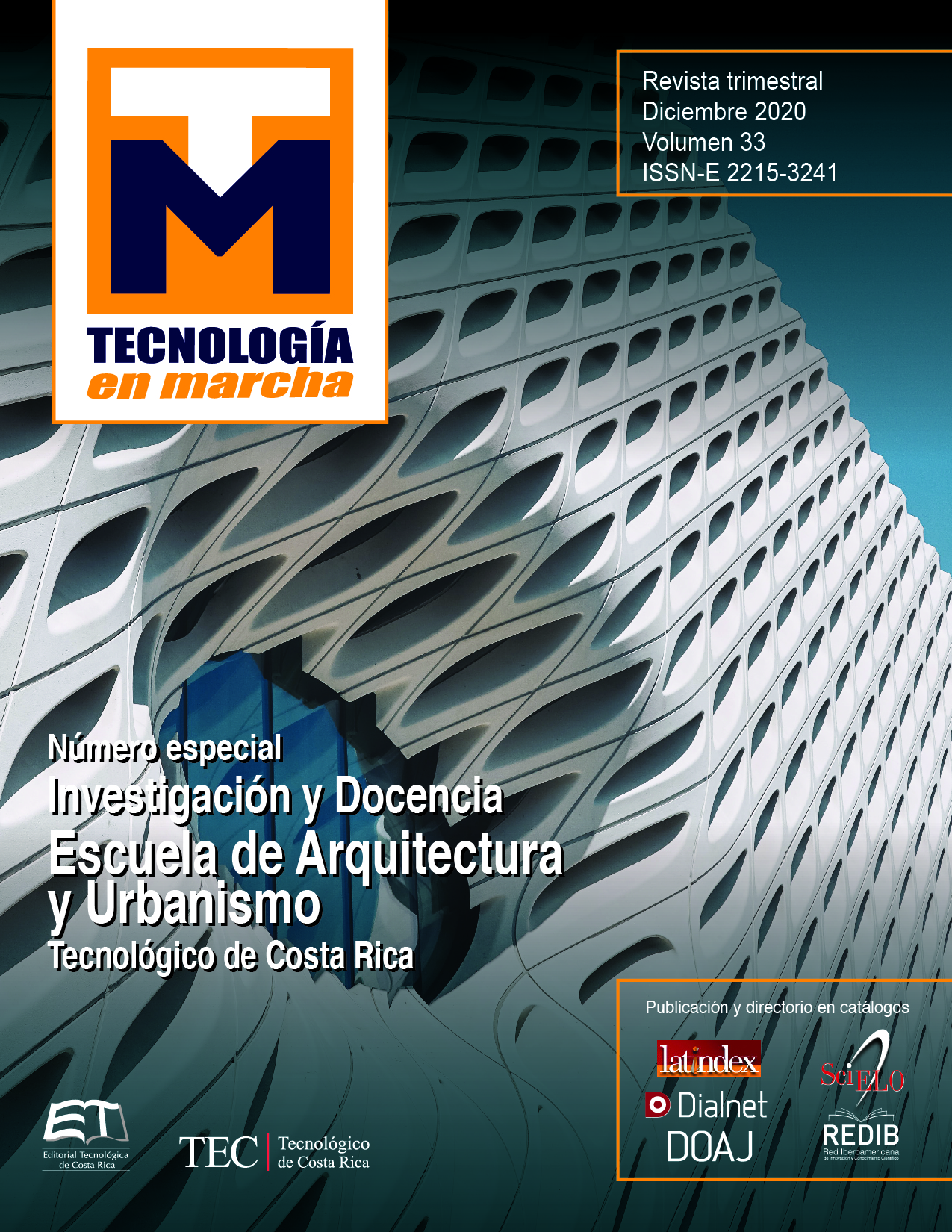Ventilation flow analysis using CFD software as a heritage conservation tool, applied to the “Antigua Capitanía” of Port Limon
Main Article Content
Abstract
Fungi hinder the conservation processes of heritage assets since they cause their biodeterioration. The spores produced by these organisms, which can also generate health complications in the property users, depend on the humidity accumulated in the materials to germinate, therefore controlling environmental conditions is decisive if making the most of each intervention performed is wanted. Computer Fluid Dynamics (CFD) applications that have been traditionally used for energy simulations are being applied to determine air currents within spaces and thereby promote conservation strategies based on natural ventilation.
This article aims to show the methodology used for the analysis of air flows within the “Antigua Capitanía” of Port Limón in Costa Rica, using the AUTODESK FlowDesign software and the data analysis strategy developed by Víctor Fuentes Freixanet and Manuel Rodríguez Viqueira . This document has as framework the research project called “ Conservation of the Caribbean Architecture in Costa Rica: use of advanced techniques to study biological agents responsible of damage in these buildings.”, developed by Costa Rica Institute of Technology and Western Illinois University.
Article Details

This work is licensed under a Creative Commons Attribution-NonCommercial-NoDerivatives 4.0 International License.
Los autores conservan los derechos de autor y ceden a la revista el derecho de la primera publicación y pueda editarlo, reproducirlo, distribuirlo, exhibirlo y comunicarlo en el país y en el extranjero mediante medios impresos y electrónicos. Asimismo, asumen el compromiso sobre cualquier litigio o reclamación relacionada con derechos de propiedad intelectual, exonerando de responsabilidad a la Editorial Tecnológica de Costa Rica. Además, se establece que los autores pueden realizar otros acuerdos contractuales independientes y adicionales para la distribución no exclusiva de la versión del artículo publicado en esta revista (p. ej., incluirlo en un repositorio institucional o publicarlo en un libro) siempre que indiquen claramente que el trabajo se publicó por primera vez en esta revista.
References
K. Sterflinger, «Fungi: Their role in deterioration of cultural heritage,» Fungal Biology Reviews, vol. 24, pp. 47-55, 2010.
N. Valentín, «Microbial contamination in archives and Museums: Health hazards and preventive strategies using air ventilation systems,» 2007.
V. Fuentes Freixanet, «Arquitectura Bioclimática, ventilación natural.,» 2015.
E. Di Carlo, R. Chisesi, B. Giovanna, S. Barbaro, G. Lombardo, R. Valentina, M. Sebastianelli, T. Giovanni y F. Palla, «Fungi and Bacteria in Indoor Cultural Heritage Environments: Microbial-r elated Ri sks for Artworks and Human Health,» Environment and Ecology Research, vol. 4, nº 5, pp. 257-264, 2016.
J. Grau-Bové, L. Mazzei, M. Strlic y M. Cassar, «Fluid simulations in heritage science,» Heritage Science, vol. 7, nº 16, 2019.
I. Hernández Salazar, D. Porras Alfaro y K. García Baltodano, «La arquitectura caribeña costarricense en la trama urbana histórica de la ciudad de Limón entre el periodo de 1871-1920,» de Tercer Congreso Internacional Hispanoamericano de Historia de la Construcción, Ciudad de México, 2019.
O. Sanou y F. Quesada, «Orden, Progreso y Civilización, 1871-1914. Transformaciones urbanas y arquitectónicas,» de Historia de la Arquitectura de Costa Rica, E. Fonseca y J. E. Garbier, Edits., San José, Museos del Banco Central y Centro de Investigaciones Históricas de Centroamérica, 1998, pp. 219-317.
R. Woodbridge, Historia de la arquitectura en Costa Rica, Cartago: Editorial Tecnológica de Costa Rica, 2003.
V. A. Fuentes Freixanet y M. Rodríguez Vaqueira, Ventilación natural: cálculos básicos para arquitectos, Ciudad de México: Universidad Autónoma Metropolitana, 2004.
American Society of Heating, Refrigerating and Air-Conditioning Engineers, «ASHRAE Handbook, Fundamentals,» ASHRAE, Atlanta, 2017.
A. Baghaei Daemei, E. Mehrinejad Khotbehsara, E. Malekian Nobarani y P. Bahrami, «Study on wind aerodynamic and flow characteristics of triangular-shaped tall buildings and CFD simulation in order to assess drag coefficient,» Ain Shams Engineering Journal, vol. 10, nº 3, pp. 541-548, 2019.
Instituto Meteorológico Nacional, «PROMEDIOS MENSUALES DE DATOS CLIMATICOS,» 2019.

